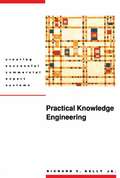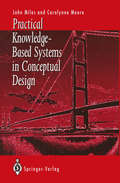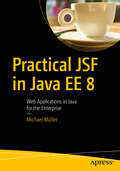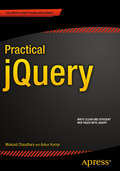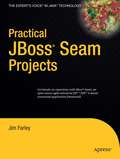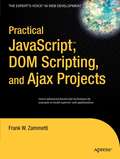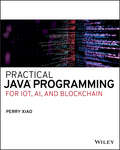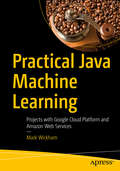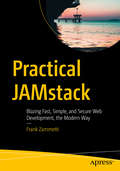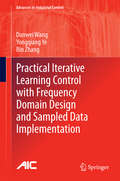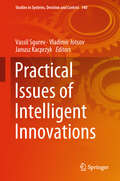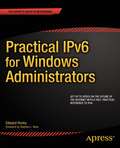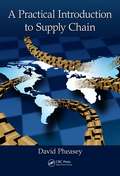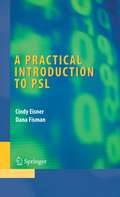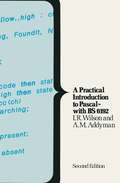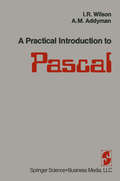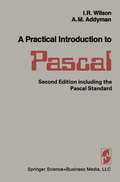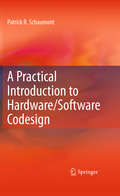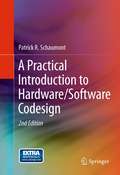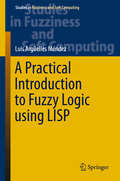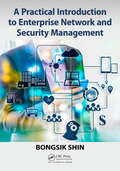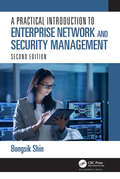- Table View
- List View
Practical Knowledge Engineering
by Richard KellyThis book provides knowledge engineers with practical methods for initiating, designing, building, managing, and demonstrating successful commercial expert systems. It is a record of what actually works (and does not work) in the construction of expert systems, drawn from the author's decade of experience in building expert systems in all major areas of application for American, European, and Japanese organizations. The book features:* knowledge engineering programming techniques* useful skills for demonstrating expert systems * practical costing and metrics* guidelines for using knowledge representation techniques* solutions to common difficulties in design and implementation
Practical Knowledge-Based Systems in Conceptual Design
by John C. Miles Carolynne J. MooreConceptual Design is one of the few areas of Engineering Design where computers have yet to make an impact. With the development of Knowledge Based Systems it is now possible to rectify this situation. This publication deals with the use of Knowledge Based Systems (KBS) as tools for conceptual design. Included are neglected aspects such as evaluation and user needs. Practical Knowledge Based Systems in Conceptual Design is based on the authors' experience of developing KBS for use in civil engineering, an area of industrial application which is recognised as being one of great potential. The methodology has been tried and tested by designers. Examples of systems which have been developed to solve specific design problems are included.
Practical JSF in Java EE 8: Web Applications in Java for the Enterprise
by Michael MüllerMaster the Java EE 8 and JSF (JavaServer Faces) APIs and web framework with this practical, projects-driven guide to web development. This book combines theoretical background with a practical approach by building four real-world applications. By developing these JSF web applications, you'll take a tour through the other Java EE technologies such as JPA, CDI, Security, WebSockets, and more.In Practical JSF in Java EE 8, you will learn to use the JavaServer Faces web framework in Java EE 8 to easily construct a web-based user interface from a set of reusable components. Next, you add JSF event handling and then link to a database, persist data, and add security and the other bells and whistles that the Java EE 8 platform has to offer.After reading this book you will have a good foundation in Java-based web development and will have increased your proficiency in sophisticated Java EE 8 web development using the JSF framework.What You Will Learn Use the Java EE 8 and the JavaServer Faces APIs to build Java-based web applications through four practical real-world case studies Process user input with JSF and the expression language by building a calculator application Persist data using JSF templating and Java Persistence to manage an inventory of books Create and manage an alumni database using JSF, Ajax, web services and Java EE 8's security features. Who This Book Is For Those new to Java EE 8 and JSF. Some prior experience with Java is recommended.
Practical jQuery
by Ankur Kumar Mukund ChaudharyPractical jQuery is your step-by-step guide to using jQuery in the real world, taking you from downloading jQuery all the way to extending it by writing your own plug-ins and testing the DOM using QUnit. jQuery is one of today’s most popular JavaScript web application development frameworks and libraries. While getting started with the tool is easy, sometimes it's not as simple to completely realize the power and automation that it can bring to your development work—and that's especially the case when you're in the middle of a project, up against a deadline.Using this book, you will learn how to use jQuery’s powerful DOM manipulation tools to dynamically update content on your site. You will be able to extend jQuery’s capabilities by writing your own plugins on top of the framework, animate elements, build your own jQuery elements, employ best practices, and avoid common errors. Practical jQuery teaches you how, with jQuery, you can unit test and refactor your code. You’ll see how expressive yet concise jQuery’s code is and how much quicker and efficient it is to develop with jQuery.Get a fundamental perspective on how jQuery works, how to understand, select, and build your own plug-ins, and how to make sure your projects run at the peak of their potential performance using Practical jQuery today.
Practical JBoss Seam Projects
by James FarleyPractical JBoss Seam® Web 2.0 Projects, written by renowned author and enterprise Java practitioner Jim Farley, is a practical, projects-based book on this groundbreaking open source lightweight JSF-EJB3 framework. It uses practical application scenarios to demonstrate the nature of the JBoss Seam framework, its efficacy, and its limitations. A series of scenarios and real-world case studies offer valuable insight into the new practices of JBoss Seam Web 2.0 development. Each demonstrates a specific element of the framework, from a PayPal-like web application project to designing rich web user interfaces using Seam and Ajax.
Practical JavaScript, DOM Scripting and Ajax Projects
by Frank ZammettiThis "learn by example" book offers 10 complete JavaScript projects that will save web developers countless hours of development time. These projects can serve as samples to learn from and/or be adapted for use in other projects. The 10 projects all address common needs in modern web applications, including a utility library, a validation framework, a GUI widget framework, a dynamic event calendar application, a drag and drop shopping cart, and more! Coverage details JavaScript best practices, Ajax techniques, and some of the most popular JavaScript libraries, such as Prototype, Script.aculo.us, and the Yahoo YUI library.
Practical Java Programming for IoT, AI, and Blockchain
by Perry XiaoLearn practical uses for some of the hottest tech applications trending among technology professionals We are living in an era of digital revolution. On the horizon, many emerging digital technologies are being developed at a breathtaking speed. Whether we like it or not, whether we are ready or not, digital technologies are going to penetrate more and more, deeper and deeper, into every aspect of our lives. This is going to fundamentally change how we live, how we work, and how we socialize. Java, as a modern high-level programming language, is an excellent tool for helping us to learn these digital technologies, as well as to develop digital applications, such as IoT, AI, Cybersecurity, Blockchain and more. Practical Java Programming uses Java as a tool to help you learn these new digital technologies and to be better prepared for the future changes. Gives you a brief overview for getting started with Java Programming Dives into how you can apply your new knowledge to some of the biggest trending applications today Helps you understand how to program Java to interact with operating systems, networking, and mobile applications Shows you how Java can be used in trending tech applications such as IoT (Internet of Things), AI (Artificial Intelligence), Cybersecurity, and Blockchain Get ready to find out firsthand how Java can be used for connected home devices, healthcare, the cloud, and all the hottest tech applications.
Practical Java Programming for IoT, AI, and Blockchain
by Perry XiaoLearn practical uses for some of the hottest tech applications trending among technology professionals We are living in an era of digital revolution. On the horizon, many emerging digital technologies are being developed at a breathtaking speed. Whether we like it or not, whether we are ready or not, digital technologies are going to penetrate more and more, deeper and deeper, into every aspect of our lives. This is going to fundamentally change how we live, how we work, and how we socialize. Java, as a modern high-level programming language, is an excellent tool for helping us to learn these digital technologies, as well as to develop digital applications, such as IoT, AI, Cybersecurity, Blockchain and more. Practical Java Programming uses Java as a tool to help you learn these new digital technologies and to be better prepared for the future changes. Gives you a brief overview for getting started with Java Programming Dives into how you can apply your new knowledge to some of the biggest trending applications today Helps you understand how to program Java to interact with operating systems, networking, and mobile applications Shows you how Java can be used in trending tech applications such as IoT (Internet of Things), AI (Artificial Intelligence), Cybersecurity, and Blockchain Get ready to find out firsthand how Java can be used for connected home devices, healthcare, the cloud, and all the hottest tech applications.
Practical Java Machine Learning: Projects with Google Cloud Platform and Amazon Web Services
by Mark WickhamBuild machine learning (ML) solutions for Java development. This book shows you that when designing ML apps, data is the key driver and must be considered throughout all phases of the project life cycle. Practical Java Machine Learning helps you understand the importance of data and how to organize it for use within your ML project. You will be introduced to tools which can help you identify and manage your data including JSON, visualization, NoSQL databases, and cloud platforms including Google Cloud Platform and Amazon Web Services.Practical Java Machine Learning includes multiple projects, with particular focus on the Android mobile platform and features such as sensors, camera, and connectivity, each of which produce data that can power unique machine learning solutions. You will learn to build a variety of applications that demonstrate the capabilities of the Google Cloud Platform machine learning API, including data visualization for Java; document classification using the Weka ML environment; audio file classification for Android using ML with spectrogram voice data; and machine learning using device sensor data.After reading this book, you will come away with case study examples and projects that you can take away as templates for re-use and exploration for your own machine learning programming projects with Java.What You Will LearnIdentify, organize, and architect the data required for ML projectsDeploy ML solutions in conjunction with cloud providers such as Google and AmazonDetermine which algorithm is the most appropriate for a specific ML problemImplement Java ML solutions on Android mobile devicesCreate Java ML solutions to work with sensor dataBuild Java streaming based solutionsWho This Book Is ForExperienced Java developers who have not implemented machine learning techniques before.
Practical JAMstack: Blazing Fast, Simple, and Secure Web Development, the Modern Way
by Frank ZammettiLearn what JAMstack is all about, what those three big letters in the front mean and why it’s so beneficial. This book shows you how to create sites and apps on the JAMstack using GatsbyJS, a tool made specifically for generating them. As part of that, you’ll learn about React, one of the hottest front-end development tools out there today. You will build three separate projects, starting with a relatively simple site to get your feet wet, then a more robust and dynamic application to see more advanced topics like API usage and data storage. Finally, you’ll build a game on the JAMstack to get a whole different perspective on how all the pieces can fit together. JAMstack, a modern take on best practices, is taking the web development world by storm and allowing developers to create web site and apps that are blazingly fast and highly secure. In many ways JAMstack is a throwback to web development of yesteryear, all while providing a simpler development experience that is streamlined by many years of best practices being brought to bear. What You'll Learn Review the principles of JAMstack: Javascript, APIs and MarkupUse React to build a front-endSet up a GitHub account and hosting using GitHub PagesHost in Netlify (the creators of JAMstack!)Understand Netlify functions and FaunaDB for persistent data storageExplore GraphQL usage for querying dataWork with the Phaser game library Who This Book Is ForWeb developers with some HTML, CSS and JavaScript experience, who want to apply best practices to build web sites that have no back-end server infrastructure while still providing dynamic content along with a streamlined development process. Architects who just want to learn JAMstack, even if they aren’t going to be hacking code all day.
Practical Iterative Learning Control with Frequency Domain Design and Sampled Data Implementation (Advances in Industrial Control)
by Danwei Wang Yongqiang Ye Bin ZhangThis book is on the iterative learning control (ILC) with focus on the design and implementation. We approach the ILC design based on the frequency domain analysis and address the ILC implementation based on the sampled data methods. This is the first book of ILC from frequency domain and sampled data methodologies. The frequency domain design methods offer ILC users insights to the convergence performance which is of practical benefits. This book presents a comprehensive framework with various methodologies to ensure the learnable bandwidth in the ILC system to be set with a balance between learning performance and learning stability. The sampled data implementation ensures effective execution of ILC in practical dynamic systems. The presented sampled data ILC methods also ensure the balance of performance and stability of learning process. Furthermore, the presented theories and methodologies are tested with an ILC controlled robotic system. The experimental results show that the machines can work in much higher accuracy than a feedback control alone can offer. With the proposed ILC algorithms, it is possible that machines can work to their hardware design limits set by sensors and actuators. The target audience for this book includes scientists, engineers and practitioners involved in any systems with repetitive operations.
Practical Issues of Intelligent Innovations (Studies in Systems, Decision and Control #140)
by Vassil Sgurev Vladimir Jotsov Janusz KacprzykThis book presents recent advances in the field of intelligent systems. Composed of fourteen selected chapters, it covers a wide range of research that varies from applications in industrial data science to those in applied science. Today the word INNOVATION is more and more connected with the words INTELLIGENT and SECURITY, as such the book discusses the theory and applications of hot topics such as big data, education applications of robots with different levels of autonomy, knowledge-based modeling and control of complex dynamical systems, sign-based synthesis of behavior, security issues with intelligent systems, innovative intelligent control design, neuromorphic computation, data-driven classification, intelligent modeling and measurement innovations, multisensor data association, personal education assistants, a modern production architecture, study of peer review and scientometrics, intelligent research on bug report data, and clustering non-Gaussian data. The broad and varied research discussed represents the mainstream of contemporary intelligent innovations that are slowly but surely changing the world.
Practical IPv6 for Windows Administrators
by Edward HorleyPractical IPv6 for Windows Administrators is a handy guide to implementing IPv6 in a Microsoft Windows environment. This is the book you need if you are a Microsoft Windows Administrator confronted with IPv6 and in need of a quick resource to get up and going. The book covers the current state of IPv6 and its support in Microsoft Windows. It provides best-practices and other guidance toward successful implementation.This book is especially written with the goal of translating your current expertise in IPv4 into the new realm of IPv6. Special attention is given to dual-stack configurations, helping you to run IPv4 and IPv6 side-by-side and support both protocol versions during a transition period. Practical IPv6 for Windows Administrators is also a fast reference you can look at to get something done quickly. It covers IPv6 addressing, management of IPv6 from Powershell, Advanced Firewall configuration, and use of IPv6 in Hyper-V and virtual networking environments. You'll find practical examples showing how IPv6 integrates with all the standard tools you use for IPv4 today, tools like DNS and DHCP. You'll also find insider knowledge on IPv6 that can help avert stumbling points on the road to deployment.Provides a quick path from IPv4 expertise to IPv6 implementation Gives best-practices specific to Windows on IPv6 and dual stack networks Is chock full of practical examples showing how to manage IPv6 on Windows
A Practical Introduction to Supply Chain
by David PheaseyIn many businesses, supply chain people are trapped in reactive roles where they source, contract, purchase, receive, warehouse, and ship as a service. However, in some businesses suppliers contribute to improvement programs, technology, funding, marketing, logistics, and engineering expertise. Breaking into a proactive supply chain role takes broad thinking, a talent for persuasion, and the courage to go after it. This book supplies proven methods to help you do so.A Practical Introduction to Supply Chain describes how to run an efficient supply chain that exceeds expectations in terms of cost, quality, and supplier delivery. It explains the need to integrate systems, the flow of information, and the way in which people work together between commercial purchasing, materials management, and distribution parts of the supply chain.Sharing powerful insights from the perspective of a supply chain manager, the book details practical techniques drawn from the author’s decades of experience. It presents methods that apply directly to supply chains involving a physical product, manufactured internally or outsourced, as well as physical operations such as oilfield services.This book demonstrates how to make a supply chain organization work in practice—contributing more to business success than traditional purchasing and logistics organizations can. In addition to writing about practical supply chain issues and approaches, the author also describes proven methods he used while working with client teams on assignments. He also details some of the ways his teams used to manage the people part of the change.
A Practical Introduction to Supply Chain
by David PheaseyIn many businesses, supply chain people are trapped in reactive roles where they source, contract, purchase, receive, warehouse, and ship as a service. However, in some businesses suppliers contribute to improvement programs, technology, funding, marketing, logistics, and engineering expertise. Breaking into a proactive supply chain role takes broad thinking, a talent for persuasion, and the courage to go after it. This book supplies proven methods to help you do so.A Practical Introduction to Supply Chain describes how to run an efficient supply chain that exceeds expectations in terms of cost, quality, and supplier delivery. It explains the need to integrate systems, the flow of information, and the way in which people work together between commercial purchasing, materials management, and distribution parts of the supply chain.Sharing powerful insights from the perspective of a supply chain manager, the book details practical techniques drawn from the author’s decades of experience. It presents methods that apply directly to supply chains involving a physical product, manufactured internally or outsourced, as well as physical operations such as oilfield services.This book demonstrates how to make a supply chain organization work in practice—contributing more to business success than traditional purchasing and logistics organizations can. In addition to writing about practical supply chain issues and approaches, the author also describes proven methods he used while working with client teams on assignments. He also details some of the ways his teams used to manage the people part of the change.
A Practical Introduction to PSL (Integrated Circuits and Systems)
by Cindy Eisner Dana FismanThis book describes the Property Specification Language PSL, recently standardized as IEEE Standard 1850-2005. PSL was developed to fulfill the following requirements: easy to learn, write, and read; concise syntax; rigorously well-defined formal semantics; expressive power, permitting the specification for a large class of real world design properties; known efficient underlying algorithms in simulation, as well as formal verification. Basic features are covered, as well as advanced topics such as the use of PSL in multiply-clocked designs. A full chapter is devoted to common errors, gathered through the authors' many years of experience in using and teaching the language.
A Practical Introduction to Pascal
by WILSON/ADDYMANThe popularity of Pascal as a teaching language has rapidly increased, as demonstrated by Addyman's survey conducted over a11 European and American institutions (Comput. Bull., Se ries 2,8, June 1976,31). This is due both to the desirable features of the language and to the ease of producing an efficient com piler. As an instance of the latter, the authors have investigated the full CDC CYBER compiler and found it to throughput at 1.8 times the rate of the manu facturer's Fortran compiler. These features of the language and compilers have also been favourably regarded by system programmers and users of rnicroprocessors. In the latter field, it is the belief of the authors that Pascal will supersede the programming language BASIC. Specifically, undergraduates in the Department of Computer Science at Manchester University program largely in Pascal. An introductory le~ture course on basic programming techniques, given at Manchester, has been taken as a basis for this book. In addition to lectures, the course consists of two kinds of practical session. The first is based on the solution of short pencil-and-paper exercises. The second requires the student to write complete programs and run them in an 'edit and go' mode on interactive computer terminals. Each chapter of the book conc1udes with exercises and problems suitable for these purposes. Although solutions to a11 of these are not presented in the book, teaching staff may obtain them by application to the authors.
A Practical Introduction to Pascal
by WILSON/ADDYMANSince the first edition of this book was written in 1977, there has been a tremendous increase in the use of Pascal. This increased use has had two significant effects. (1) It has produced a bett er understanding of the facilities of Pascal and their use. (2) It has fostered the production of the ISO standard for Pascal. This second edition reflects both this better understanding and the clarifications and changes to Pascal which have resulted from the production of the BSljlSO Pascal standard. The standard (BS 6192, which supplies the technical content for ISO 7185) is the definitive document on Pascal. My work on the Pascal standard has convinced me that the description of a programming language may be tutorial, or it may be definitive, or it may be neither! The chapters of this book do not constitute a definitive description of Pascal. They are essentially tutorial. The book is based on an introductory lecture course given at Manchester. In addition to lectures, the course consists of two kinds of practical work. The first is based on the solution of short pencil-and-paper exercises. The second requires the student to write complete programs and run them using interactive computer terminals. Each chapter of the book concludes with exercises and problems suitable forthese purposes. Although solutions to all of these are not presented in the book, teaching staff may obtain them by application to the authors.
A Practical Introduction to Hardware/Software Codesign
by Patrick R. SchaumontThis is a practical book for computer engineers who want to understand or implement hardware/software systems. It focuses on problems that require one to combine hardware design with software design – such problems can be solved with hardware/software codesign. When used properly, hardware/software co- sign works better than hardware design or software design alone: it can improve the overall performance of digital systems, and it can shorten their design time. Hardware/software codesign can help a designer to make trade-offs between the ?exibility and the performanceof a digital system. To achieve this, a designer needs to combine two radically different ways of design: the sequential way of dec- position in time, using software, with the parallel way of decomposition in space, using hardware. Intended Audience This book assumes that you have a basic understandingof hardware that you are - miliar with standard digital hardware componentssuch as registers, logic gates, and components such as multiplexers and arithmetic operators. The book also assumes that you know how to write a program in C. These topics are usually covered in an introductory course on computer engineering or in a combination of courses on digital design and software engineering.
A Practical Introduction to Hardware/Software Codesign
by Patrick R. SchaumontThis textbook serves as an introduction to the subject of embedded systems design, with emphasis on integration of custom hardware components with software. The key problem addressed in the book is the following: how can an embedded systems designer strike a balance between flexibility and efficiency? The book describes how combining hardware design with software design leads to a solution to this important computer engineering problem. The book covers four topics in hardware/software codesign: fundamentals, the design space of custom architectures, the hardware/software interface and application examples. The book comes with an associated design environment that helps the reader to perform experiments in hardware/software codesign. Each chapter also includes exercises and further reading suggestions. Improvements in this second edition include labs and examples using modern FPGA environments from Xilinx and Altera, which will make the material in this book applicable to a greater number of courses where these tools are already in use. More examples and exercises have been added throughout the book. “If I were teaching a course on this subject, I would use this as a resource and text. If I were a student who wanted to learn codesign, I would look for a course that at least used a similar approach. If I were an engineer or engineering manager who wanted to learn more about codesign from a very practical perspective, I would read this book first before any other. When I first started learning about codesign as a practitioner, a book like this would have been the perfect introduction.” --Grant Martin, Tensilica--
A Practical Introduction to Fuzzy Logic using LISP (Studies in Fuzziness and Soft Computing #327)
by Luis Argüelles MendezThis book makes use of the LISP programming language to provide readers with the necessary background to understand and use fuzzy logic to solve simple to medium-complexity real-world problems. It introduces the basics of LISP required to use a Fuzzy LISP programming toolbox, which was specifically implemented by the author to “teach” the theory behind fuzzy logic and at the same time equip readers to use their newly-acquired knowledge to build fuzzy models of increasing complexity. The book fills an important gap in the literature, providing readers with a practice-oriented reference guide to fuzzy logic that offers more complexity than popular books yet is more accessible than other mathematical treatises on the topic. As such, students in first-year university courses with a basic tertiary mathematical background and no previous experience with programming should be able to easily follow the content. The book is intended for students and professionals in the fields of computer science and engineering, as well as disciplines including astronomy, biology, medicine and earth sciences. Software developers may also benefit from this book, which is intended as both an introductory textbook and self-study reference guide to fuzzy logic and its applications. The complete set of functions that make up the Fuzzy LISP programming toolbox can be downloaded from a companion book’s website.
A Practical Introduction to Enterprise Network and Security Management
by Bongsik ShinComputer networking and cybersecurity are challenging subjects, partly because of the constant rise and fall of related technologies and IT paradigms. As the title implies, much focus of this book is on providing the audience with practical, as well as, theoretical knowledge necessary to build a solid ground for a successful professional career. A Practical Introduction to Enterprise Network and Security Management contains 12 chapters of the correct amount of coverage for a semester or quarter. It balances introductory and fairly advanced subjects on computer networking and cybersecurity to deliver effectively technical and managerial knowledge. It explains sometimes challenging concepts in a manner that students can follow with careful reading. A Practical Introduction to Enterprise Network and Security Management is designed to offer impactful, hands-on learning experiences without relying on a computer lab. First, each chapter comes with practical exercise questions. In the class setting, they are good as individual or group assignments. Many of them are based on simulated or real cases, and take advantage of actual industry products and systems for a reader to better relate theories to practice. Second, there are a number of information-rich screen shots, figures, and tables in each chapter carefully constructed to solidify concepts and thus enhance visual learning. A Practical Introduction to Enterprise Network and Security Management Is written for students studying management information systems, accounting information systems, or computer science in a semester of 15 to 16 weeks, and exposed to the subject for the first time Takes advantage of many real cases and examples, and actual industry products and services (software, hardware, and configurations) so that students can better relate concepts and theories to practice Explains subjects in a systematic, but very practical manner that students can follow through Provides students with practical understanding of both computer networking and cybersecurity Contains highly practical exercise questions, which can be individual or group assignments within or without the class, included in each chapter to reinforce learning. In addition to the thorough technical details, managerial issues including, enterprise network planning, design, and management from the practitioner’s perspective are embedded throughout the text to assist balanced learning. Bearing in mind of the critical importance of security in today’s enterprise networks, the text discusses the implications of network design and management on enterprise security whenever appropriate. Lastly, to reinforce knowledge in security management further, two chapters introduce the fundamentals of cybersecurity in terms of threat types and defense techniques.
A Practical Introduction to Enterprise Network and Security Management
by Bongsik ShinComputer networking and cybersecurity are challenging subjects, partly because of the constant rise and fall of related technologies and IT paradigms. As the title implies, much focus of this book is on providing the audience with practical, as well as, theoretical knowledge necessary to build a solid ground for a successful professional career. A Practical Introduction to Enterprise Network and Security Management contains 12 chapters of the correct amount of coverage for a semester or quarter. It balances introductory and fairly advanced subjects on computer networking and cybersecurity to deliver effectively technical and managerial knowledge. It explains sometimes challenging concepts in a manner that students can follow with careful reading. A Practical Introduction to Enterprise Network and Security Management is designed to offer impactful, hands-on learning experiences without relying on a computer lab. First, each chapter comes with practical exercise questions. In the class setting, they are good as individual or group assignments. Many of them are based on simulated or real cases, and take advantage of actual industry products and systems for a reader to better relate theories to practice. Second, there are a number of information-rich screen shots, figures, and tables in each chapter carefully constructed to solidify concepts and thus enhance visual learning. A Practical Introduction to Enterprise Network and Security Management Is written for students studying management information systems, accounting information systems, or computer science in a semester of 15 to 16 weeks, and exposed to the subject for the first time Takes advantage of many real cases and examples, and actual industry products and services (software, hardware, and configurations) so that students can better relate concepts and theories to practice Explains subjects in a systematic, but very practical manner that students can follow through Provides students with practical understanding of both computer networking and cybersecurity Contains highly practical exercise questions, which can be individual or group assignments within or without the class, included in each chapter to reinforce learning. In addition to the thorough technical details, managerial issues including, enterprise network planning, design, and management from the practitioner’s perspective are embedded throughout the text to assist balanced learning. Bearing in mind of the critical importance of security in today’s enterprise networks, the text discusses the implications of network design and management on enterprise security whenever appropriate. Lastly, to reinforce knowledge in security management further, two chapters introduce the fundamentals of cybersecurity in terms of threat types and defense techniques.
A Practical Introduction to Enterprise Network and Security Management
by Bongsik ShinA Practical Introduction to Enterprise Network and Security Management, Second Edition, provides a balanced understanding of introductory and advanced subjects in both computer networking and cybersecurity. Although much of the focus is on technical concepts, managerial issues related to enterprise network and security planning and design are explained from a practitioner’s perspective. Because of the critical importance of cybersecurity in today’s enterprise networks, security-related issues are explained throughout the book, and four chapters are dedicated to fundamental knowledge. Challenging concepts are explained so readers can follow through with careful reading. This book is written for those who are self-studying or studying information systems or computer science in a classroom setting. If used for a course, it has enough material for a semester or a quarter. FEATURES Provides both theoretical and practical hands-on knowledge and learning experiences for computer networking and cybersecurity Offers a solid knowledge base for those preparing for certificate tests, such as CompTIA and CISSP Takes advantage of actual cases, examples, industry products, and services so students can relate concepts and theories to practice Explains subjects in a systematic and practical manner to facilitate understanding Includes practical exercise questions that can be individual or group assignments within or without a classroom Contains several information-rich screenshots, figures, and tables carefully constructed to solidify concepts and enhance visual learning The text is designed for students studying information systems or computer science for the first time. As a textbook, this book includes hands-on assignments based on the Packet Tracer program, an excellent network design and simulation tool from Cisco. Instructor materials also are provided, including PowerPoint slides, solutions for exercise questions, and additional chapter questions from which to build tests.
